How to Speak “Kitchen Design” with the Pros
Farmhouse, Industrial, Transitional, French Country… when it comes to kitchen design styles, there’s a very long list. If you find it challenging to define your personal design style or describe your vision, then read on. Our seasoned Swartz kitchen and bath designers have years of experience listening and helping clients decipher which style will work best with their wants and needs. You don’t need to “speak design” in order to co-create a great space with a designer but using a few key terms can be an effective shorthand for explaining your preferences without having to scroll through Instagram or Pinterest together. Once your designer knows your style aesthetic, he or she can contribute even more ideas and suggestions to personalize and perfect your very own kitchen design. These style names also come in handy when selecting cabinetry and shopping for fixtures, lighting, flooring, and appliances.
Start with the Big Three Kitchen Design Styles: Traditional and Transitional, Contemporary
Whereas some design aesthetics are decidedly distinctive (think florals and chintz for Shabby Chic or soft blues, whites and greens for a Coastal vibe), three of today’s most popular design sensibilities are very broad, in terms of what they encompass. These design styles are: traditional, transitional, and contemporary. If you can identify which of these three styles you resonate with most, you’re already on the path to having a great design conversation:
Traditional: Rooted in European influences, traditional design honors timeless features, like elegant marble surfaces, classic details, and sumptuous furnishings. Traditional kitchens often feature richly stained, detailed wood cabinetry, saturated colors, and multi-layered textures and accessories. Traditional design might be reminiscent of a gentleman’s library, a Tuscan-inspired kitchen, or an English manor.
Transitional: As the name implies, a transitional kitchen sits right in the middle of traditional and contemporary design styles, borrowing elements of both. It’s a very popular style because transitional strikes a nice balance that’s not “too much”. Typically, the color palette in a transitional style is neutral, creating a calming and relaxed atmosphere that is stylish and sleek, yet also warm and inviting. In a transitional design, you might see plush furnishings paired with modern materials like steel and glass. “A little bit country and a little bit rock ‘n roll”, transitional kitchens prove to be very strong in the real estate market as nearly anyone can imprint their style on them using accents and accessories.
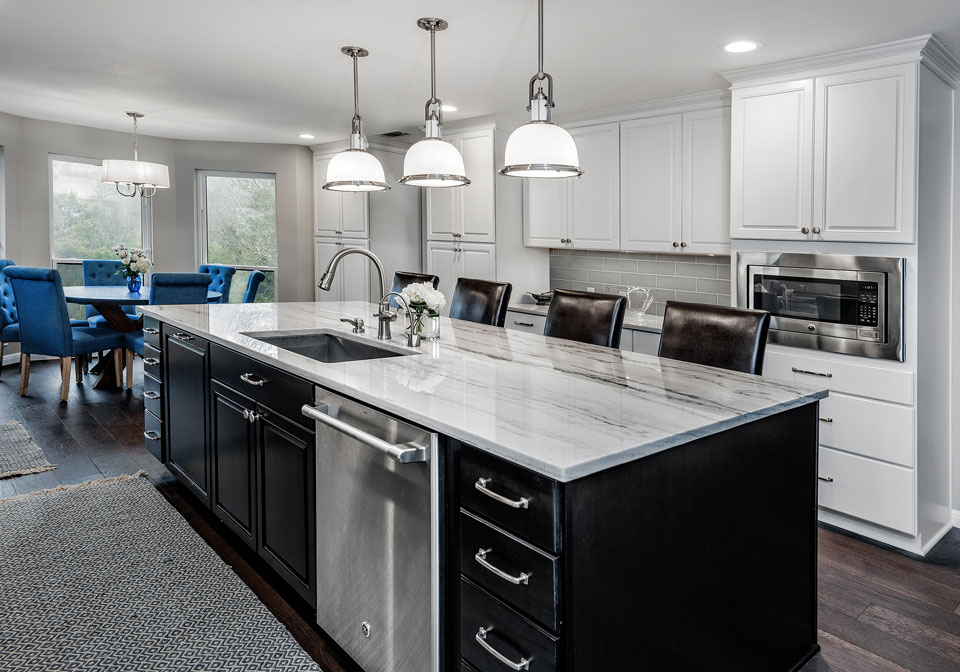
Contemporary: Sometimes, contemporary is confused with modern design. But whereas modern design follows a very strict and minimalistic discipline, contemporary kitchens are much more fluid; they reflect current design and lifestyle trends without adhering to one particular style. The contemporary look is all about form and function. Clean lines, a lack of clutter, and an emphasis on sleekness and simplicity dominate. In a contemporary kitchen, you can expect to see natural materials granite or quartz countertops and solid wood cabinetry with frameless doors that offer clean, smooth surfaces. Open floor plans, expansive floor and countertop space, and natural light are hallmarks of contemporary kitchen design.
Choose a House Style
Farmhouse: Sometimes, the style of your house — or the idea of a particular house — can inform your kitchen design. For example, one of the most popular looks in recent years is a farmhouse-inspired kitchen design. This style feels familiar, warm and welcoming, which is what we want a kitchen to be. Farmhouse is also a versatile, mixing well with other styles. Whether you want to incorporate industrial elements or more traditional kitchen features, they’ll pair seamlessly with the farmhouse style. The modern farmhouse kitchen is often white or cream with pops of color (like the kitchen island). Vintage focal points such as apron sinks and retro industrial pendant lights complete the look.
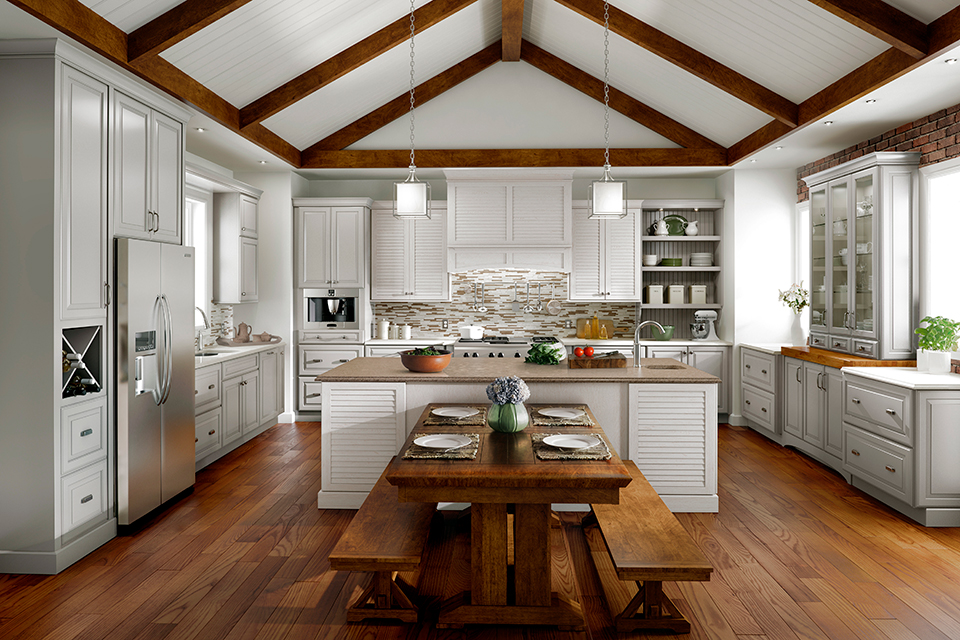
Craftsman: The craftsman kitchen is all about carefully chosen and well-finished details. Handmade tiles, dark stained wood, and rich textures and finishes are all featured in the craftsman style.
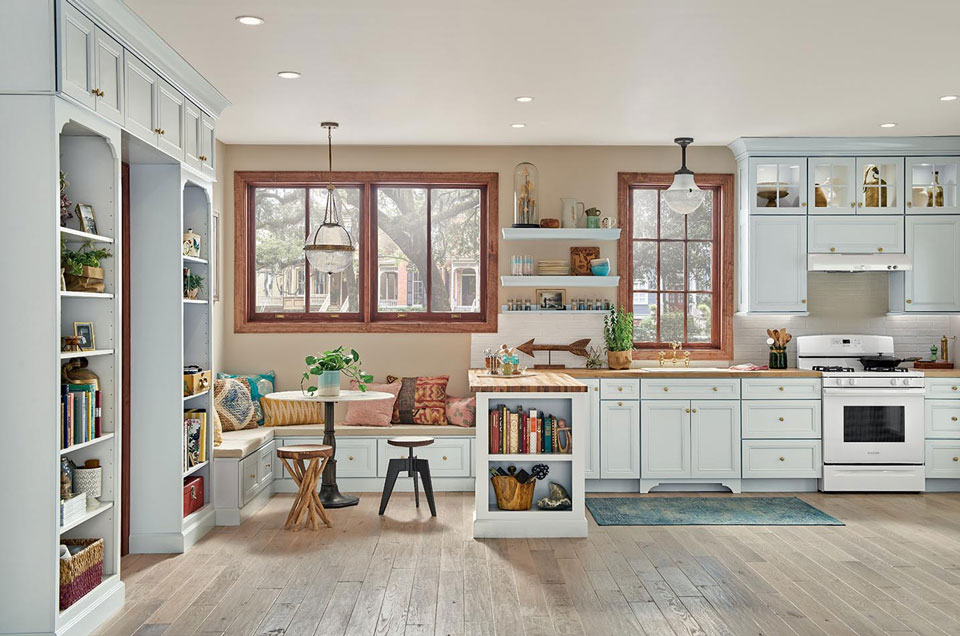
Pick a Time Period
Mid-Century Modern: Mid-century modern kitchen design is a throwback to design style of the 1950s and 60s. Mad Men-retro nostalgia mixes with some elements of minimalism. Functional and fuss-free, mid-century modern design is all about sleek, frameless cabinetry, matte finishes, and marble or quartz countertops.
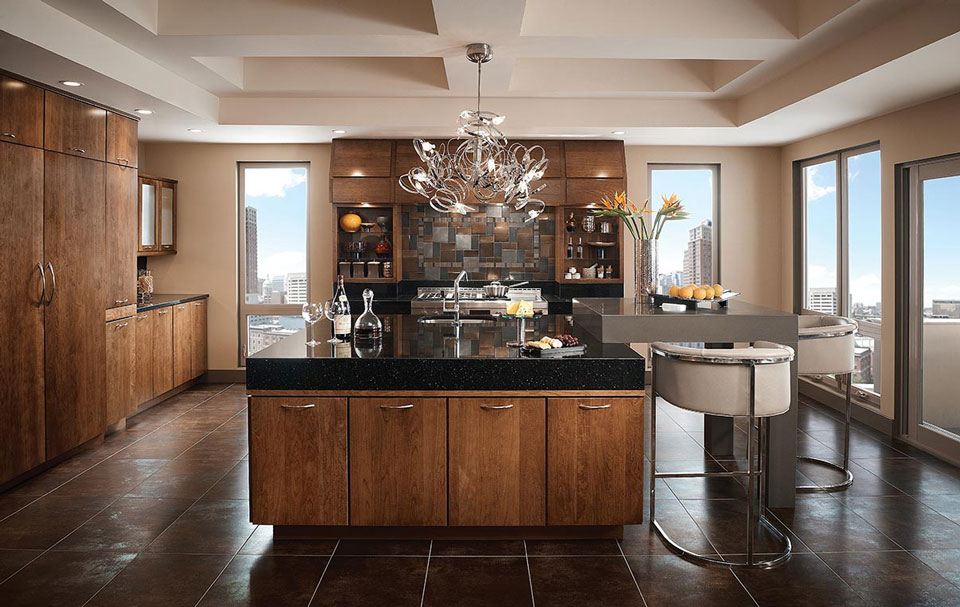
Modern or Minimalism: Modern design is a strict interpretation of the 20th century design aesthetic. It utilizes crisp, clean lines, a simple color palette, and modern materials like metal, glass and steel. Sleek simplicity reigns supreme: modern design is streamlined — you won’t see a lot of clutter or accessories. Minimalist kitchen design takes modern design one step further by simplifying it with neutral color tones, ultra-clean lines, and a focus on functionality.
Elaborate with Elements
Perhaps you’re a huge fan of rustic, textured wood. Or, maybe you like the look of urban lofts and industrial warehouses. If you’re a world traveler, you might want to incorporate baskets, textiles, or folk art you’ve acquired during your travels. Sometimes, great kitchen design starts with specific elements.
Industrial: Industrial kitchens focus on workhorse materials like subway tile, stainless steel, and concrete. For former industrial buildings renovated into living spaces, the industrial kitchen is a cool, modern choice. There’s a sense of unfinished rawness in many of the elements, and it’s not uncommon to see exposed brick, wood beams, and ductwork. Think high ceilings, metal pendant light fixtures, and large-scale colorful abstract art that adds a dash of color to an otherwise neutral color palette defined by the woods and metals in the space.
Bohemian: Bohemian design reflects a carefree, globe-trotting lifestyle where rules are made to be broken. Elements of this kitchen design aesthetic may include vintage light fixtures, globally inspired textiles and rugs, and seemingly incongruent pairings of items like an ultra-chic retro chandelier and a nomadic tapestry rug. With this eclectic design style, nearly anything goes.
Describe Signature Regional Looks
Coastal/Hamptons: Coastal kitchen design (aka The Hamptons design style) centers around light, airy color schemes that pair neutrals with blues and greens. Kitchen cabinetry is often painted white or beige. Tile backsplashes are often reflective glass tiles in sea glass blues and greens. Elements of wood, woven baskets, and accessories inspired by the sea complete the coastal feel. A coastal kitchen design is meant to create a relaxed and comfortable environment that makes every day feel like summer vacation.
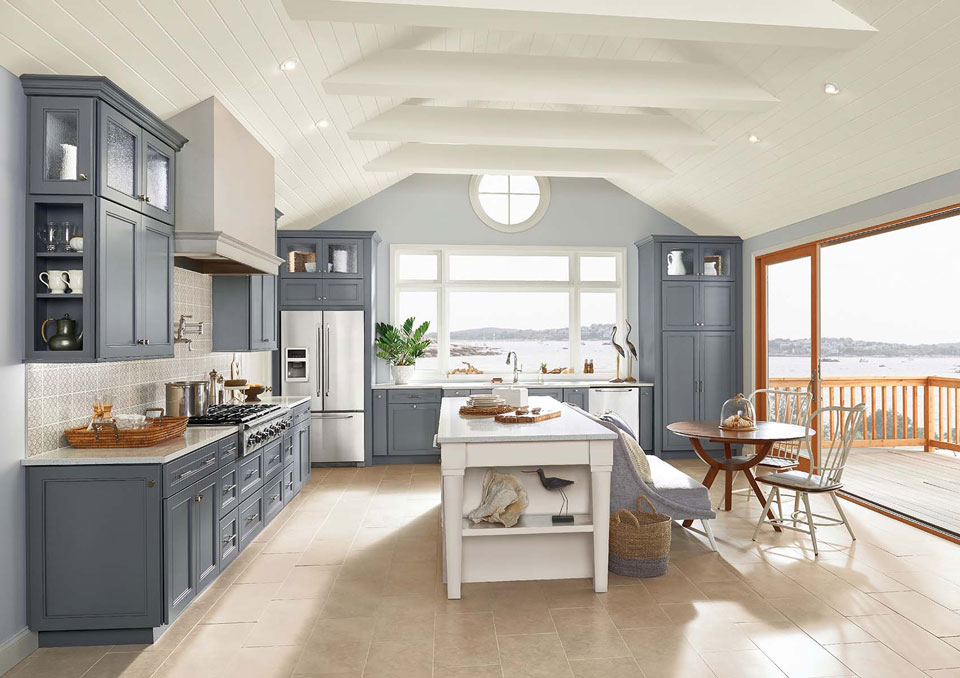
Mediterranean/Tuscan/French Country: Warm, earthy colors are hallmarks of both Mediterranean and French Country kitchen design. Reminiscent of an Old-World farmhouse, design elements include rustic woods, stone, brick, and warm tones of red, yellow and gold. These kitchens often feature pizza ovens and display collections of ornate porcelain dishes and copper pots and pans.
Create Your Own Style
These are just a few of the many kitchen design styles that might speak to you. Whether you lean toward rustic or Scandinavian design, the joy of working with a kitchen designer is that your finished space will feature your exact personal style no matter which category or categories it may fall under. To begin dreaming up your new kitchen, contact Swartz Kitchens & Baths. With or without the vocabulary to express your inspired vision, our kitchen designers will help you build the framework for your ideal kitchen.
How to Speak “Kitchen Design” with the Pros
Farmhouse, Industrial, Transitional, French Country… when it comes to kitchen design styles, there’s a very long list. If you find it challenging to define your personal design style or describe your vision, then read on. Our seasoned Swartz kitchen and bath designers have years of experience listening and helping clients decipher which style will work best with their wants and needs. You don’t need to “speak design” in order to co-create a great space with a designer but using a few key terms can be an effective shorthand for explaining your preferences without having to scroll through Instagram or Pinterest together. Once your designer knows your style aesthetic, he or she can contribute even more ideas and suggestions to personalize and perfect your very own kitchen design. These style names also come in handy when selecting cabinetry and shopping for fixtures, lighting, flooring, and appliances.
Start with the Big Three Kitchen Design Styles: Traditional and Transitional, Contemporary
Whereas some design aesthetics are decidedly distinctive (think florals and chintz for Shabby Chic or soft blues, whites and greens for a Coastal vibe), three of today’s most popular design sensibilities are very broad, in terms of what they encompass. These design styles are: traditional, transitional, and contemporary. If you can identify which of these three styles you resonate with most, you’re already on the path to having a great design conversation:
Traditional: Rooted in European influences, traditional design honors timeless features, like elegant marble surfaces, classic details, and sumptuous furnishings. Traditional kitchens often feature richly stained, detailed wood cabinetry, saturated colors, and multi-layered textures and accessories. Traditional design might be reminiscent of a gentleman’s library, a Tuscan-inspired kitchen, or an English manor.
Transitional: As the name implies, a transitional kitchen sits right in the middle of traditional and contemporary design styles, borrowing elements of both. It’s a very popular style because transitional strikes a nice balance that’s not “too much”. Typically, the color palette in a transitional style is neutral, creating a calming and relaxed atmosphere that is stylish and sleek, yet also warm and inviting. In a transitional design, you might see plush furnishings paired with modern materials like steel and glass. “A little bit country and a little bit rock ‘n roll”, transitional kitchens prove to be very strong in the real estate market as nearly anyone can imprint their style on them using accents and accessories.

Contemporary: Sometimes, contemporary is confused with modern design. But whereas modern design follows a very strict and minimalistic discipline, contemporary kitchens are much more fluid; they reflect current design and lifestyle trends without adhering to one particular style. The contemporary look is all about form and function. Clean lines, a lack of clutter, and an emphasis on sleekness and simplicity dominate. In a contemporary kitchen, you can expect to see natural materials granite or quartz countertops and solid wood cabinetry with frameless doors that offer clean, smooth surfaces. Open floor plans, expansive floor and countertop space, and natural light are hallmarks of contemporary kitchen design.
Choose a House Style
Farmhouse: Sometimes, the style of your house — or the idea of a particular house — can inform your kitchen design. For example, one of the most popular looks in recent years is a farmhouse-inspired kitchen design. This style feels familiar, warm and welcoming, which is what we want a kitchen to be. Farmhouse is also a versatile, mixing well with other styles. Whether you want to incorporate industrial elements or more traditional kitchen features, they’ll pair seamlessly with the farmhouse style. The modern farmhouse kitchen is often white or cream with pops of color (like the kitchen island). Vintage focal points such as apron sinks and retro industrial pendant lights complete the look.

Craftsman: The craftsman kitchen is all about carefully chosen and well-finished details. Handmade tiles, dark stained wood, and rich textures and finishes are all featured in the craftsman style.

Pick a Time Period
Mid-Century Modern: Mid-century modern kitchen design is a throwback to design style of the 1950s and 60s. Mad Men-retro nostalgia mixes with some elements of minimalism. Functional and fuss-free, mid-century modern design is all about sleek, frameless cabinetry, matte finishes, and marble or quartz countertops.

Modern or Minimalism: Modern design is a strict interpretation of the 20th century design aesthetic. It utilizes crisp, clean lines, a simple color palette, and modern materials like metal, glass and steel. Sleek simplicity reigns supreme: modern design is streamlined — you won’t see a lot of clutter or accessories. Minimalist kitchen design takes modern design one step further by simplifying it with neutral color tones, ultra-clean lines, and a focus on functionality.
Elaborate with Elements
Perhaps you’re a huge fan of rustic, textured wood. Or, maybe you like the look of urban lofts and industrial warehouses. If you’re a world traveler, you might want to incorporate baskets, textiles, or folk art you’ve acquired during your travels. Sometimes, great kitchen design starts with specific elements.
Industrial: Industrial kitchens focus on workhorse materials like subway tile, stainless steel, and concrete. For former industrial buildings renovated into living spaces, the industrial kitchen is a cool, modern choice. There’s a sense of unfinished rawness in many of the elements, and it’s not uncommon to see exposed brick, wood beams, and ductwork. Think high ceilings, metal pendant light fixtures, and large-scale colorful abstract art that adds a dash of color to an otherwise neutral color palette defined by the woods and metals in the space.
Bohemian: Bohemian design reflects a carefree, globe-trotting lifestyle where rules are made to be broken. Elements of this kitchen design aesthetic may include vintage light fixtures, globally inspired textiles and rugs, and seemingly incongruent pairings of items like an ultra-chic retro chandelier and a nomadic tapestry rug. With this eclectic design style, nearly anything goes.
Describe Signature Regional Looks
Coastal/Hamptons: Coastal kitchen design (aka The Hamptons design style) centers around light, airy color schemes that pair neutrals with blues and greens. Kitchen cabinetry is often painted white or beige. Tile backsplashes are often reflective glass tiles in sea glass blues and greens. Elements of wood, woven baskets, and accessories inspired by the sea complete the coastal feel. A coastal kitchen design is meant to create a relaxed and comfortable environment that makes every day feel like summer vacation.

Mediterranean/Tuscan/French Country: Warm, earthy colors are hallmarks of both Mediterranean and French Country kitchen design. Reminiscent of an Old-World farmhouse, design elements include rustic woods, stone, brick, and warm tones of red, yellow and gold. These kitchens often feature pizza ovens and display collections of ornate porcelain dishes and copper pots and pans.
Create Your Own Style
These are just a few of the many kitchen design styles that might speak to you. Whether you lean toward rustic or Scandinavian design, the joy of working with a kitchen designer is that your finished space will feature your exact personal style no matter which category or categories it may fall under. To begin dreaming up your new kitchen, contact Swartz Kitchens & Baths. With or without the vocabulary to express your inspired vision, our kitchen designers will help you build the framework for your ideal kitchen.